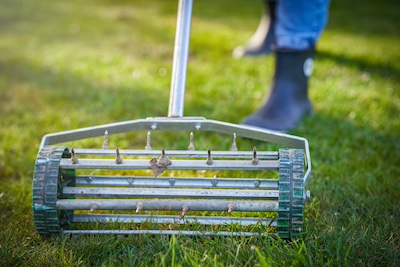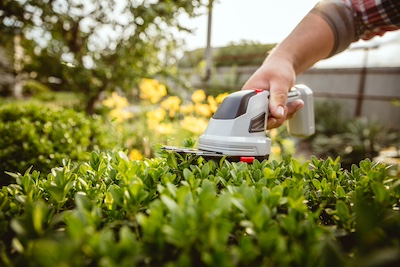Understanding Lawn Care Tool Needs
Proper lawn care is a blend of science and art, requiring a keen understanding of the environment your grass calls home. This guide sheds light on how to assess and meet the needs of your lawn, ensuring it remains healthy and vibrant through every season using the best lawn care tool for your needs.
1. Assess Sunlight Exposure
The first step in understanding your lawn’s needs is to observe how much sunlight it receives daily. Does your lawn bask in full sunlight, enjoy partial shade, or reside mostly in the shade?
Grass types have varying sunlight needs, with some thriving in full sun and others preferring shaded areas. Identifying your lawn’s sun exposure allows you to choose the appropriate grass type or seed that best fits the environment.
2. Soil Test for pH and Nutrient Levels
Conducting a soil test will reveal your reveal your soil’s pH level. Most lawns flourish in slightly acidic to neutral soil (pH 6.2 to 7.0). If your soil’s pH is outside this range, you might need to adjust it with lime (to raise the pH) or sulfur (to lower the pH).
The test also guides you on which nutrients are lacking, whether it be nitrogen, phosphorus, or potassium, allowing for a targeted fertilization approach.
3. Understand Water Requirements
Knowing how much water your lawn needs can save you time and resources. Overwatering encourages shallow root systems and fungal growth. Conversely, underwatering stresses the grass.
The general rule is that lawns require about 1 to 1.5 inches of water per week, either from rainfall or irrigation 1. However, factors such as grass type, soil type, and climate can adjust this guideline.
4. Identify Grass Type
Understanding the type of grass you have is crucial since different grass types have unique care requirements. Cool-season grasses, such as Kentucky bluegrass and fescue, have different growth patterns and peak times than warm-season grasses like Bermuda or St. Augustine.
Each grass type will have particular mowing height preferences and seasonal care differences.
5. Frequent Checks for Pests and Diseases
Regularly inspect your lawn for signs of pests or diseases. Yellow patches, thinning grass, and bare spots can indicate underlying issues that require specific treatments. Early identification and treatment can prevent more extensive damage.

Choosing the Right Mower for Your Lawn’s Terrain and Size
Mowing your lawn is a task that combines the tranquility of being outdoors with the satisfaction of home improvement. Your lawn’s size and terrain are critical factors in deciding which mower will make your landscaping chores efficient and enjoyable. Here’s a guide to help you match your lawn with the perfect mower.
For Small, Flat Lawns
If your lawn is relatively flat and under half an acre, a push reel mower or an electric reel mower may be all you need. Push reel mowers are quiet, environmentally friendly, and suitable for small lawns. They offer a bit of a workout but have minimal maintenance and no fuel costs.
Electric reel mowers are a step up in convenience. Whether corded or battery-powered, these mowers are eco-friendly and quiet but take less manual effort to operate. They’re perfect for maintaining small lawns without the fuss of gas engines.
For Medium-Sized Lawns
Lawns ranging from half an acre to an acre call for something with more power and efficiency. Gas-powered push mowers or self-propelled mowers are good options. Self-propelled models are beneficial for uneven terrain or slight inclines, reducing the physical effort. They navigate through the grass smoothly and can cut down on mowing time.
For Large Lawns
For those with more than an acre of grass to maintain, investing in a riding lawn mower or a zero-turn mower becomes practical. Riding mowers are comfortable, efficient, and have a higher mowing capacity. This means you can cover a lot of ground quickly.
Zero-turn mowers take efficiency a step further with their superior maneuverability, allowing you to navigate around trees, flower beds, and other obstacles with ease. They’re ideal for large, open spaces but also excel in yards with intricate landscaping.
Considerations for Hilly or Uneven Lawns
If your lawn is uneven, you’ll need a mower that’s up to the challenge. Self-propelled rotary mowers are excellent for mildly uneven surfaces due to their larger wheels and adjustable speed settings.
For more dramatic hills or uneven terrain, look for a riding mower with good traction and low center of gravity to ensure safety and effectiveness. Zero-turn mowers might not always be the best choice for steep slopes due to their high maneuverability, which can pose challenges in maintaining control on inclines.
Choosing the right lawn mower based on your lawn’s size and terrain impacts how neatly your grass is cut, the amount of time you spend on it, and the overall health of your lawn. Remember to factor in storage space for your mower and maintenance capabilities.
Whichever type of mower you opt for, safety should always be a top priority; understanding how to operate your equipment will help keep you and your lawn looking sharp.

Essential Lawn Care Tool for Maintenance
After addressing basic needs like sunlight exposure, water, and regular checks for pest control, selecting the appropriate tools can elevate your lawn care. To foster a thriving lawn, let’s explore some indispensable tools:
Garden Rakes
Garden rakes play a role in leveling soil and collecting debris such as leaves and twigs. Before you begin seeding or aeration, use a garden rake to create an even surface. This ensures seeds make good contact with the soil, vital for germination and growth.
Lawn Aerators
Over time, the soil becomes compacted, reducing its ability to absorb water and nutrients. A lawn aerator relieves this compaction. For smaller lawns, a manual aerator suffices, entering the soil to create small holes. These openings allow air, water, and nutrients to penetrate deeper, enriching the soil foundation of your lawn.
Seed Spreaders
When reseeding your lawn or applying fertilizer, a seed spreader ensures even coverage. There are hand-held versions for smaller areas and push models for more expansive lawns. Using a spreader helps prevent over-seeding or fertilizer burn by distributing products uniformly.
Pruning Shears and Hedge Trimmers
Regularly pruning your lawn’s borders and any hedges ensures healthier plant growth. It helps in eliminating diseased or pest-infested sections of plants. Choose pruning shears for smaller, more precise cuts and hedge trimmers for shaping edges and controlling size.
Lawn Care Tool Watering Solutions: Sprinklers and Hoses
A consistent watering schedule underpins a healthy lawn. In areas lacking frequent rainfall, an efficient sprinkler system covers large swathes evenly. For more direct water applications or smaller areas, hoses with spray attachments allow for versatility.
Leaf Blowers
Especially in fall, leaves can accumulate quickly, smothering grass. A leaf blower cleans these away swiftly, preventing decay and mold growth which could harm your lawn’s health.
Lawn Care Tool Personal Protective Equipment
Safety should never be overlooked. From gloves that protect hands during soil amendment to ear protection when using louder machines like lawnmowers and leaf blowers, it’s essential to gear up appropriately.

Choosing the Best Lawn Care Tool for Your Yard
With these tools, you’ll be equipped to tackle every aspect of lawn maintenance from aeration to mowing. Each plays a part in a holistic lawn care strategy that serves to enhance the vitality and appearance of your green space.
A healthy lawn is not only a testament to your hard work but also a sanctuary for you and your family to enjoy.
- Lawn Watering Guide. Virginia Cooperative Extension. https://www.pubs.ext.vt.edu/430/430-010/430-010.html. Accessed June 1, 2023.

